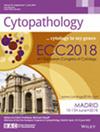Characteristic morphology and immunohistochemical patterns of clear cell papillary renal cell tumours may be observed in renal cell carcinomas, a critical pitfall in renal biopsy cytopathology
Abstract
Background
Clear cell papillary renal cell tumour (CCPRCT) was renamed from previous clear cell papillary renal cell carcinoma (CCPRCC) in the latest WHO Classification of Tumours. It is essential to differentiate RCC from CCPRCT in renal mass biopsies (RMB).
Design
RMB cases with subsequent resections were reviewed. The pathology reports and pertinent clinical information were recorded.
Results
Fifteen cases displaying either CCPRCT morphology (20% diffuse, 67% focal) or immunohistochemical patterns (cup-like CA9: 20% diffuse, 47% focal; CK7: 33% diffuse, 40% focal) were identified. One case was positive for TFE3. TSC mutation was identified in one case. Both cases exhibited both CCPRCT morphology and immunohistochemical patterns for CA9 and CK7, with focal high-grade nuclei. RMB diagnoses were as follows: 6 (40%) as CCRCC, 2 (13%) as CCPRCT, 2 (13%) as CCRCC versus CCPRCT, 2 (13%) as CCRCC versus PRCC, 1 (7%) as RCC with TSC mutation versus CCPRCT, 1 (7%) as TFE3-rearranged RCC versus PRCC, and 1 (7%) as cyst with low-grade atypia. 71% of patients underwent nephrectomy, 21% received systemic treatment for stage 4 RCCs, and 7% with ablation for small renal mass (1.6 cm) with low-grade CCRCC.
Conclusions
Our study highlights that morphologic and immunochemical features of CCPRCT may be present in RCCs, including RCC-TFE3 expression and TSC-associated RCC, a critical pitfall to misdiagnose aggressive RCC as indolent CCPRCT and result in undertreatment. Careful examination of morphology and immunostains for CA9, CK7, and TFE3, as well as molecular tests, is crucial for distinguishing aggressive RCC from indolent CCPRCT.


 求助内容:
求助内容: 应助结果提醒方式:
应助结果提醒方式:


